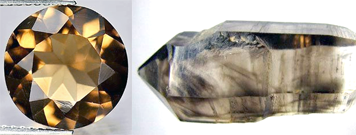 Photo of Smoky Quartz in Processed & Rough Form
Photo of Smoky Quartz in Processed & Rough Form
Smoky Quartz is a mineral with a hardness of 7 out of 10 on the Mohs scale of mineral hardness [?]. These Trigonally structured gems are made of silicon dioxide, their full chemical compound being SiO2.
Smoky or Brown Quartz is a commonly occurring quartz mineral that gets it's name from the smoky or cloudy interior.
A well polished piece of yellowish smoky quartz may appear like amber, while a well cut one may look similar to a brown tourmaline or andalusite.
With a Mohs hardness of 7 quartz in general is well suited for jewelry as it will hold a facet or edge fairly well.
Variations called Morion (black) and Cairngorm (smoky) have been found in large deposits throughout the world.
How can I tell if my Smoky Quartz is natural or irradiated?
Natural Smoky Quartz shows gradual color zoning and often has brownish rather than black coloring. Irradiated specimens typically show more uniform, darker color. Many commercial stones are irradiated, but the process is stable and accepted.
Why do some pieces look almost black?
Very dark or black specimens, often called Morion, contain higher levels of natural radiation exposure or have been artificially irradiated. The darkest pieces often come from granite pegmatites or have been enhanced.
Does Smoky Quartz fade in sunlight?
Natural Smoky Quartz may gradually lighten with prolonged sun exposure. The color is caused by natural radiation affecting aluminum impurities in the crystal. Both natural and treated stones should be stored away from strong light.
Are Scottish Smoky Quartz more valuable?
Scottish Cairngorm (named after the mountains where found) has historical significance and collector value. While not necessarily higher quality, these specimens command premium prices due to tradition and scarcity.
Why are some specimens called Diamond Quartz?
Particularly clear, faceted Smoky Quartz with light brown color sometimes gets marketed as Smoky Diamond Quartz. This is just a trade name; they're still Smoky Quartz but of premium clarity and cut.
Do heat-treated stones lose their color?
Heat can actually remove the smoky color, returning the crystal to clear quartz. This is why genuine Smoky Quartz should never be cleaned with hot water or steam. Once heated, the color cannot be restored naturally.
The specific gravity [?] for Smoky Quartz is 2.65, its refractive index [?] is 1.54-1.55, and its double refraction [?] is 0.009.
History
Smoky Quartz has been used as a healing stone, and in many rituals throughout the ages. It has been thought by many to contain mystical properties.
Quartz has been used to make arrow and spear heads in the ancient past.
Industrial Usages
Quartz is used to create silicone chips in wafer form. Quartz is used in glass making.









